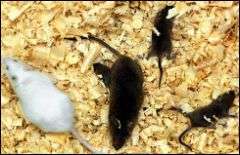April 28, 2010 report
Mice (and possibly humans) make their own morphine

(PhysOrg.com) -- New research has confirmed that mice have the biochemical pathways required to manufacture morphine from intermediates. Morphine is a powerful drug usually derived from the opium poppy, but scientists have long speculated animals may be able to synthesize it, especially as they have brain receptors responding specifically to morphine. Tetrahydropapaveroline (THP) and other alkaloid precursors of morphine have been discovered in brain tissue and urine, but until now animal studies were largely inconclusive because of the difficulty of excluding environmental contaminants. The new research gives more conclusive evidence that excludes the possibility of contamination.
Researcher Dr Meinhart Zenk, from the Donald Danforth Plant Science Center in St Louis, Missouri, injected mice each day with THP and other morphine precursors and then analyzed the mouse urine samples. The potential precursors injected into the mice were labeled with deuterium and could therefore be distinguished from any morphine contaminants found in the environment or in the food. The alkaloids were isolated from the urine and then examined using mass spectrometry.
The analyses identified a number of intermediate steps in the biochemical pathway between THP and morphine. One of these was a four-ringed molecule called salutaridine, a metabolite of THP found in the biochemical pathway that synthesizes morphine in the opium poppy. When they injected salutaridine into the mice they found thebaine, a five-ringed opiate in the urine. Injecting thebaine resulted in codeine, morphine, and a third opiate, oripavine, being identified in the urine.
Dr Zenk said the later stages of morphine production are the same in the opium poppy and mammals, but the stages preceding salutaridine differ in that the precursor has an extra hydroxyl (OH) group in animals. The difference is enough to suggest the morphine pathway in mammals and plants evolved independently.
Zenk and his colleagues did not find morphine in the mouse blood or tissues, and so the research does not prove the morphine produced was used for any purpose such as pain relief, or that it was involved in an addiction. It does not prove that humans and other mammals also possess the same biochemical pathways, but it seems likely since traces of morphine have been found previously in human urine as well as mouse urine.
The team plans to use more sensitive techniques to identify traces of morphine in tissues, and further research is needed to identify enzymes involved in the biochemical pathways. More work also needs to be done to show whether or not the endogenous morphine exists naturally and has a significant function, although Zenk said because morphine is found “we have to consider that there must be a function for it.” One of the future research projects Zenk hopes to do is to find out if people suffering from pain have raised levels of endogenous morphine.
The paper is published online in the Proceedings of the National Academy of Sciences (PNAS).
More information: Urinary excretion of morphine and biosynthetic precursors in mice, Proceedings of the National Academy of Sciences, Published online before print April 26, 2010, doi:10.1073/pnas.1003423107
© 2010 PhysOrg.com
















